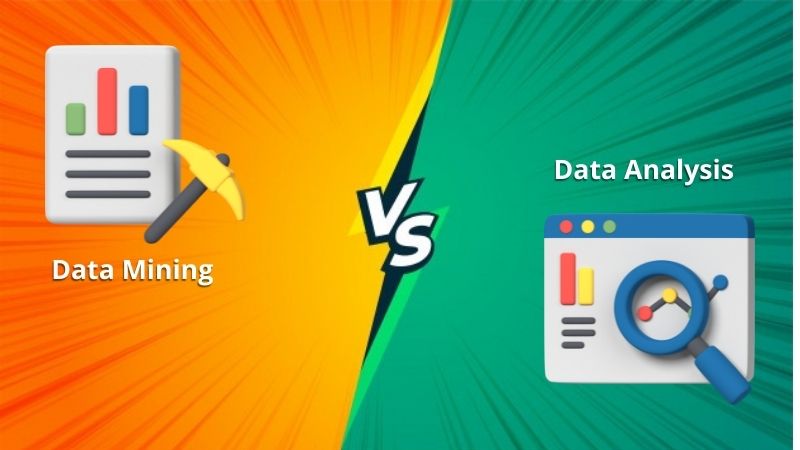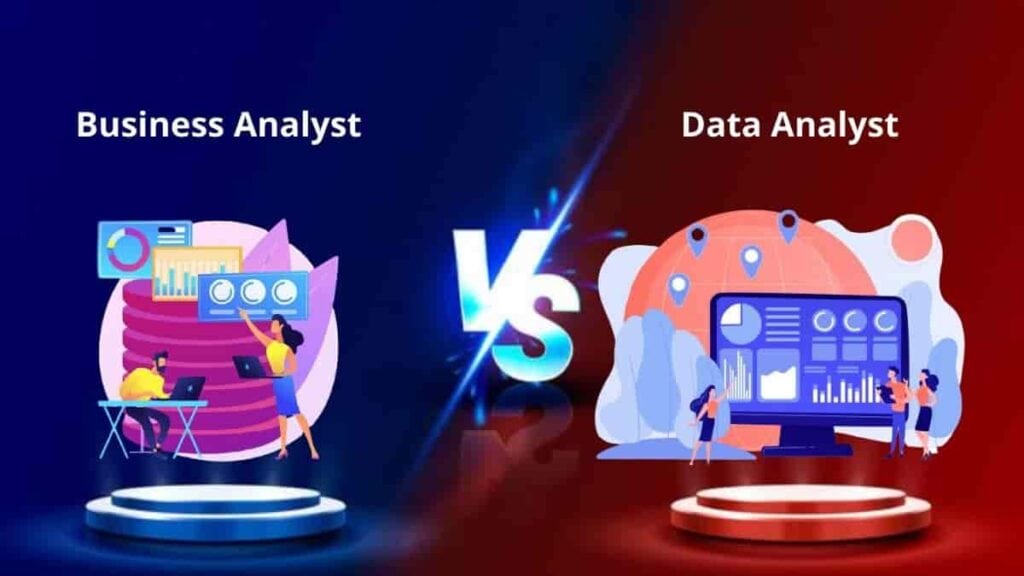In data mining vs data analysis, data mining deals with raw data to find patterns while data analysis convert the data into valuable insights.
Are you feeling exhausted while searching for data mining vs data analysis? If yes, then we have the best solution for you. We will tell you the most significant difference between data mining vs data analysis. And with the help of this blog, you will not just understand the difference between these processes but also know more about these unique techniques.
Nowadays, data is everything, and it has become the most precious asset for an individual, organization, or even a country. There are billions of data gathered every day on different devices and mediums. Therefore it emerges from the need for information and knowledge revolution. Data is the key to almost every technology. Without data, it is pretty hard to build up technology or strategy.
How is data mining used in data analysis?
Table of Contents
We can also say that data mining is the foundation of data analysis. Data mining is all about exploring, analyzing, and gathering large blocks of information. And then glean it into the meaningful patterns and trends. Data mining is used for database marketing, fraud detection, spam email filtering, surveys, and more.
What are the types of data mining?
Have a look at different types of data mining methods:-
- Association.
- Prediction.
- Classification.
- Decision Trees.
- Clustering Analysis.
- Outlier Analysis or Anomaly Analysis.
- Neural Network.
- Sequential Patterns or Pattern Tracking.
As a statistics student, you may be well aware that not every piece of data is valuable when performing a specific action or making a decision. That is why data mining and data analysis come into existence to gather meaningful insights from massive amounts of existing data.
However, you and I know that the ultimate goal of these techniques is to promote the most valuable data that will be used for business intelligence purposes. Most of us skip data analysis and consider it within data mining techniques. But both of these processes are quite different from each other. Keep in mind that both of them are the subset of business intelligence. Let’s talk about the comparison between data mining vs data analysis
Data Mining
Data mining is a process used to gather data from a large dataset. It is a systematic and sequential process to identify and discover hidden patterns from a massive amount of datasets. In other words, it is a process that converts the raw data into meaningful data. Data mining can gather data from different databases simultaneously; it is also known as Knowledge discovery in databases. Data mining is all about data research and deciding which data source is most useful for the business.
Data Mining Techniques
Have a look at data mining techniques:-
Classification analysis
As the name suggests, it is used to classify the data into different classes. It is used to restore vital information related to data and metadata from massive datasets.
Association Rule Learning
This technique refers to the process that enables us to identify relationships between distinct variables in the large data set.
Outlier detection
It is used to identify which data doesn’t match the expected pattern in a given database.
Clustering Analysis
It helps to define the collection of similar data within the cluster.
Regression Analysis
Regression analysis is the process of analyzing and identifying the relationship among different variables.
Data Analysis
Data analysis is one step further process than data mining. We can say that it is the next step of data science technology. Data analysis is the set of techniques such as extracting, cleansing, transforming, modeling, and visualizing the data. With the help of all these techniques, data analysis offers the best and most valuable data that can be further used to make decisions. It has been there since 1960. Now you can imagine how robust and reliable data analysis is.
Methods of Data Analysis
Data analysis methods are divided into two parts:-
Qualitative research
Qualitative research is all about quality-related information. It means that it doesn’t deal with any numeric data but deals with the quality of the product.
Quantitative research
Quantitative research deals with numeric data that is why it is the inverse of qualitative research. Therefore it deals with every numeric data such as price, quantity, etc.
Data analysis techniques
- Regression analysis
- Monte Carlo simulation
- Factor analysis
- Cohort analysis
- Cluster analysis
- Time series analysis
- Sentiment analysis
Data Mining vs Data Analysis Skills
Data Mining Skills Required
As we have discussed earlier, data mining requires a combination of skills, i.e., machine learning, statistics, databases, etc. Let’s have a detailed skill set needed for data mining.
- Hands-on experience with operating systems like Linux, Windows, etc.
- Machine learning
- Programming languages such as Python Programming and JavaScript
- Data analysis tools expertise such as NoSQL and SAS.
- Aware of industry trends
- Public Speaking Skills
- Deep statistics knowledge
- Data structure and algorithms knowledge
- Business intelligence skills
- Deep learning and natural language processing
Apart from these skills, the data mining expert should have interpersonal, problem-solving, and decision-making skills.
Data Analysis Skills Required
Data analysis skills are also quite similar to data mining. But it requires some more skills, such as computer science, mathematics, etc., because it is an entire industry. Have a look at the critical skills for data analysis
- Strong knowledge and awareness of industry trends.
- Deep mathematics knowledge for numerical data processing.
- Data analysis tools such as NoSQL and SAS.
- Keen understanding of machine learning concepts.
- Critical thinking and problem-solving skills.
- Data visualization skills
- Good command over MS Excel
- Presentation Skills
- Deep understanding of programming such as R or Python
- Good communication skills
Apart from these skills, the data analyst should work with the team. Or we can say that we work as a team leader in the data analysis project.
Data Mining vs Data Analysis Career Opportunity
Career Opportunities in Data Mining
- Data analyst
- Business analyst
- Data scientist
- Social media analyst
- Digital marketing analyst
Career Opportunities in Data Analysis
- Financial Analyst
- Business analyst
- Budget analyst
- Sales analytics
- Machine learning analyst
- Social media data analyst
- Business product analyst
Data Mining vs Data Analysis Tools
Data Mining Tools
- Rapid Miner
- Oracle Data Mining
- IBM SPSS Modeler
- Knime
- Python
- Orange
- Kaggle
- Rattle
- Weka
- Teradata
Data Analysis Tools
- Google Data Studio
- Microsoft Excel
- Tableau
- Tableau
- KNIME
- Power BI
- Apache Spark
- QlikView
- Talend
- Splunk
Also Read
- Top 10 Data Mining Projects Ideas Solving Real Life Problems
- Top Useful Applications of Data Mining in Different Fields
- Best Data Analytics Projects for Students to Enhance their Skills
Data Mining vs Data Analysis Comparison Table
Given below is the comparison table between Data Mining vs Data Analysis.
| Basis for Comparison | Data Mining | Data Analysis |
| Definition | It is the process to extract specific patterns from a large set of raw data. | It is the process to convert the data into insightful information to make decisions. |
| Area of expertise | It requires the knowledge of statistics, machine learning, and databases. | It requires knowledge of computer science, data visualization tools, statistics, mathematics, and machine learning. |
| Work Profile | The working procedure of a data mining expert is to build a machine learning algorithm that can find meaningful patterns from a large set of raw data. Keep in mind that usually data analysts perform the job of data mining. | Data analysis involves lots of functions such as extraction, cleaning, transformation, modeling and data visualization. For this they need to work with machine learning and different types of statistics software. |
| Responsibilities | Data mining responsibility is used to extract and discover meaningful patterns from the raw data. | Data analysis is responsible for developing models, explaining, testing and hypotheses using analytical methods. |
| Output | The output of a data mining task is to get the most valuable data patterns. | The output of data analysis is the insightful data that can be used for decision making. |
| Examples | Ecommerce, job portals are real examples of data mining. | Business analytics tools are the best example of data analysis. |
Data Mining vs Data Analysis Interest Chart
Red graphs indicate data mining and blue graphs indicate data analysis. For this infographic, you have seen that data analysis is quite popular as compared with data mining. The reason is that data mining is quite specific while data analysis is versatile.
Key Differences Between Data Mining vs Data Analysis
We have a basic idea that data mining and data analysis are two different processes. But still, most of the students are not sure about the difference and can use these processes interchangeably. Although in some cases, we have seen that most of the students considered data mining in data analysis. In other words, they think that mining the data is part of data analysis. Let’s compare these processes based on some key points to know the difference.
Core Functionality
Data mining is the process that can be used to identify the hidden patterns in massive datasets. On the other hand, data analysis is the process of getting insights and modeling and testing hypotheses from the given datasets filtered by data mining.
Activities
Data mining is the initial activity of data science technology. Remember that data mining is not a complete process; it is the core activity of data analysis, science, and big data.
On the other hand, data analysis is an entire activity. It includes extraction, collection, preparation, and modeling of the data to get valuable insights. Data analysis can be a subset of data science, business intelligence, and big data to make their world quite easy.
Study Pattern
Data mining is used to gather unstructured data and then convert the most valuable data into a structured format. That is why this study revolves around structured data.
On the other hand, data analysis works with both structured and unstructured data. Therefore the study pattern includes both structured and unstructured data.
Learning Curve
It is pretty hard to say that data mining is relatively easy compared with data analysis because it also includes many different techniques and technology to learn. But it is not as tricky as data analysis. The reason is that data analysis included some more advanced technologies to learn. Therefore data analysis has a steep learning curve.
Goal
Data Mining’s goal is to convert raw data into valuable information. In comparison, data analysis is used to get the hypothesis or the insights that help to make business decisions.
Hypothesis
Data Mining doesn’t need any hypothesis to identify the pattern or trend in the data. On the other hand, Data Analysis tests a given hypothesis to decide the data.
Data Visualization
Data mining is gathering the data, not representing the data. That is why data visualization is not involved in data mining. On the other hand, data analysis requires data visualization techniques to represent the data.
Conclusion
In the end, we can say that data analysis is offering more opportunities for us. In comparison of data mining vs data , data mining is quite specific to some tasks. These processes are quite useful in data science, big data, and business intelligence. Data mining is the fundamental process, while data mining is one step further that includes a complete package.
One doesn’t need to work on data science after data analysis. Data analysis is a comprehensive process to make decisions. Thus, data analysis has a slight edge over data mining. Both of these processes are interrelated to each other and also require different skills.
But in my opinion, you should not only focus on data mining. It would be best if you learned data mining and data analysis to get better opportunities. And don’t worry about the future scope of these processes because they remain in trends as long as humans deal with the data and make decisions based on the data. Get the best data analysis assignment help from our experts at affordable charges.
Frequently Asked Questions
What is difference between data analysis and data mining?
The significant difference between data analysis and data mining is that data analysis focuses on solving business analytics problems and working with data-driven analytical models. On the other hand, data mining uses scientific and mathematical models and methods. It helps to identify the patterns and trends in the data mined by data mining software. In simple words, we say that data analysis works with the given data sets while data mining is used to mine the raw data using different methods.
What is data analysis and mining?
Data mining and data analysis work for business intelligence. It means that both of them are subsets of business intelligence. They work with data warehouses, database management, online analytical processing, and many more. These techniques are used seamlessly with data science and big data technologies.


